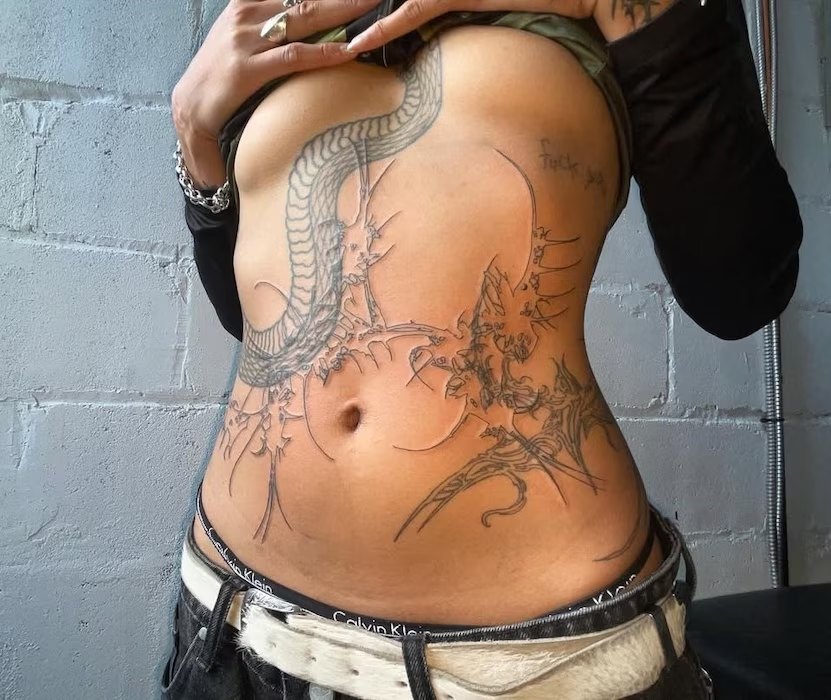Cybersigilism the controversial, cyborgian tattoo style has hacked its way into the mainstream, merging technology, mythology, and body art into something eerily futuristic. These tattoos are not for the faint-hearted; they’re intricate, surreal, and dripping with mechanical sensuality. Defined by fine-lined, greyscale patterns that resemble veins, circuits, or alien hieroglyphs, cybersigilism mirrors our ever-growing digital entanglement with the modern world.
We first heard about this strange visual language in early 2022, when writer Günseli Yalcinkaya described it as “post-human or nu-tribal” an evolution of early 2000s tribal tattoos fused with H.R. Giger’s biomechanical nightmares. Since then, the movement has exploded across Instagram and TikTok, becoming Gen Z’s radical rebellion against minimalism and traditional tattoo norms.
Much like the chaotic Y2K revival, cybersigilism taps into a feeling of nostalgia and technological anxiety. It’s messy, it’s alien, and it’s deeply human. If you’ve seen someone at a warehouse rave in Berlin or a gallery opening in London sporting glowing silver lines snaking down their arm chances are, it’s cybersigilism.
Below, we spotlight seven tattoo artists who are pushing the digital frontier of body art and redefining what it means to ink the future.
1. @generalmatter – The Machine Made Flesh
Known for their symmetrical, razor-sharp designs, General Matter has become one of the key figures of cybersigilism. Their tattoos often blend the precision of mechanical schematics with organic structures like bones, nerves, and roots. Each line feels intentional, resembling alien circuitry etched into the skin.
Their pieces have a haunting rhythm the kind that feels both artificial and alive. Often working in pure black and grey, General Matter’s work evokes a feeling of transformation, as if the wearer has fused with their digital self.
Signature style: ultra-fine symmetry, biomechanical veins, minimalist palettes.
Location: Los Angeles, USA.
Follow for: dark, geometric elegance with a cyberpunk twist.
2. @mimi.tattoo – Ethereal Digital Chaos
Mimi brings a feminine, delicate hand to the cybersigilist realm. Her tattoos float between lightness and menace, featuring flowing lines and dreamlike distortions. Unlike the harsh metallic tones typical of the genre, Mimi’s work often incorporates softer gradients and a surreal fluidity, almost like liquid code running through the skin.
Her designs look like something out of a dystopian fairytale perfect for those who want their tattoos to feel futuristic yet spiritual.
Signature style: flowing micro-lines, vaporwave-inspired gradients, surreal balance.
Location: Seoul, South Korea.
Follow for: ethereal, post-human elegance and Y2K-futurist blends.
3. @psyborg_tattoo – The Neo-Industrial Visionary
Psyborg is one of cybersigilism’s loudest voices, transforming industrial chaos into living art. His designs feature brutalist motifs — bolts, armor plates, robotic joints interlaced with biological shapes. The result? Tattoos that look like exoskeletons, making wearers appear part machine, part warrior.
This artist’s aesthetic draws heavily from industrial music, cyberpunk film, and even video game armor designs. It’s unapologetically intense, appealing to those who see tattoos as armor rather than decoration.
Signature style: mechanical plating, glitch textures, dystopian symbolism.
Location: Berlin, Germany.
Follow for: maximalist biomechanical tattoos with raw, industrial grit.
4. @voidreign – Where Spirituality Meets Cyberspace
Void Reign approaches cybersigilism through a spiritual, almost ritualistic lens. Their tattoos incorporate sigils, runes, and occult-inspired symmetries layered with cybernetic patterns. The result feels sacred as if each design is a portal or spell coded into the flesh.
They’re one of the few artists bridging digital art, AI design, and ancient mysticism. Many of their designs start as AI-generated sketches that are later hand-refined into tattooable formats.
Signature style: AI-assisted sigils, occult motifs, techno-ritual fusion.
Location: Toronto, Canada.
Follow for: mystical-mechanical aesthetics and AI-driven tattoo concepts.
5. @ka0z.x – The Dark Hacker of Flesh
If you’re into the grungier side of cybersigilism think Y2K goths, data corruption, and digital decay Ka0z.x is your artist. Their tattoos resemble glitching code, with broken lines and scattered fragments that seem to vibrate under the skin.
He’s known for layering texture upon texture, turning each tattoo into a living piece of digital noise. Many of his clients describe the experience as a visual manifestation of the internet’s chaos a permanent reminder of our digital addiction.
Signature style: glitchcore patterns, corrupted visuals, heavy contrasts.
Location: Paris, France.
Follow for: chaotic, dark, data-inspired skin art.
6. @cyberangel.ink – The Soft Cyborg Aesthetic
Cyberangel reimagines cybersigilism through a lens of softness and romance. Instead of hard, industrial lines, they favor feathered gradients and angelic symmetry. Their work often merges cyber aesthetics with celestial imagery think circuit halos, robotic wings, and neon halos.
Their designs have become especially popular among queer and femme communities who are reclaiming the harshness of tech aesthetics through tenderness and self-expression.
Signature style: angelic symmetry, soft metallic shading, emotional futurism.
Location: London, UK.
Follow for: divine, dreamy, emotionally charged digital tattoos.
7. @inkedbylyra – The AI Visionary
Lyra represents the next evolution of cybersigilism a complete fusion of technology and creativity. She uses generative AI tools to design complex, interlocking patterns before translating them onto skin with meticulous precision. Her tattoos often look like blueprints for imaginary machines or living systems.
Beyond her tattooing, Lyra also creates digital installations exploring the body’s relationship to data and consciousness. Her work pushes the boundaries of what tattooing can be less about rebellion, more about evolution.
Signature style: AI-generated schematics, abstract architecture, precision in motion.
Location: Tokyo, Japan.
Follow for: AI-art-meets-body-tech tattoo concepts that look straight out of the future.
What Makes Cybersigilism So Powerful?
At its core, cybersigilism is more than an aesthetic it’s a statement about identity in the digital age. Tattoos have always been about transformation, belonging, and rebellion. But cybersigilism takes this a step further: it explores what it means to exist in a world where the line between human and machine is blurring.
This genre challenges traditional tattoo forms by embracing imperfection, abstraction, and machine logic. Every jagged line or warped symbol reflects our relationship with technology both intimate and invasive.
For many wearers, these tattoos represent digital rebirth. They turn the body into a canvas for digital mythology, a new language of symbols that expresses life in an algorithmic era.
Why Cybersigilism Is Here to Stay
Like Y2K fashion or techno music, cybersigilism feeds off the cultural pulse of the times anxiety, nostalgia, and evolution. It’s the tattoo world’s response to digital overload and a need for individuality in a hyperconnected landscape.
Social media has amplified its reach, with hashtags like #cybersigilism, #biomechanicart, and #digitaltattoos racking up millions of views. Artists are blending techniques from 3D design, AI rendering, and digital art software to push the form further.
And just like traditional tribal tattoos once symbolized spiritual strength or belonging, cybersigilism now symbolizes resilience in an increasingly synthetic world.
Final Thoughts: The Future of Ink Is Digital
Cybersigilism might have started as a niche internet aesthetic, but it’s rapidly evolving into a legitimate tattoo movement with global reach. It’s not just a look it’s a philosophy. The fusion of art, body, and machine redefines how we see ourselves in a cybernetic age.
So, if you’ve ever felt drawn to the futuristic, the eerie, or the otherworldly consider cybersigilism. Whether you want to look like a digital angel or a mechanical warrior, these artists are leading the way in turning technology into body art.


